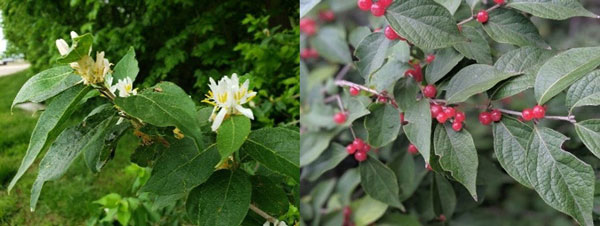Two species share the common name bush honeysuckle, Lonicera tatarica, also known as Tatarian honeysuckle and Lonicera maackii, also known as Amur honeysuckle. They are similar species that have become troublesome in forest understories throughout the Midwest. In fact, they are listed on the KDA Invasive Weed Watch List.
Ecology of bush honeysuckles
Bush honeysuckles were introduced from eastern Asia as ornamental plants during 1700s and 1800s. They have also been planted for wildlife use. Bush honeysuckles are deciduous perennial shrubs that can be found in northern and eastern Kansas, as well as much of the United States. Tatarian honeysuckle is more common in northwest Kansas, while Amur honeysuckle is more common in eastern Kansas. Bush honeysuckles leaf out earlier than most plants, giving them a competitive advantage. In addition, bush honeysuckles are known to be suppress the growth of other plants. Birds and whitetail deer eat the berries and help spread bush honeysuckles.
Identification
Seedlings emerge throughout the summer. Both Amur and Tatarian honeysuckle have opposite, egg-shaped, hairy leaves (Figure 1). Stems of new growth of Amur honeysuckle is pubescent but new Tatarian honeysuckle stems have no hairs. Mature stems of both species have light brown to gray bark that splits or peels. Stems of Amur honeysuckle grow up to 30 feet tall, while Tatarian honeysuckle grows to about 13 feet tall (Figure 2).

Figure 1. Tatarian honeysuckle seedling. Image by Ohio State Weed Lab from bugwood.org.

Figure 2. Amur honeysuckle bush. Photo by Sarah Lancaster, K-State Research and Extension.
Leaves of both species are oppositely arranged and egg-shaped to oblong with entire margins and very few hairs. Amur honeysuckle leaves are about 1 to 4 inches long, while Tatarian honeysuckle leaves reach up to about 2 1/2 inches long (Tatarian).
Both species produce pairs of flowers, about ¾-inch long, in April through June. Amur honeysuckle flowers are white to yellow and Tatarian honeysuckle flowers are pink to white. Red berries, about ¼-inch in diameter, form in late summer and persist through winter. (Figure 3).

Figure 3. Amur honeysuckle flowers (left) and berries (right). Photos by Sarah Lancaster and Walt Fick, K-State Research and Extension.
Management
Foliar applications of triclopyr (Remedy Ultra, others) or glyphosate applied in early spring or fall can control bush honeysuckles; however, these herbicides will damage other sensitive plants that are sprayed.
Cutting or mowing bush honeysuckles will not be effective, unless regrowth is prevented with a cut stump herbicide application. Glyphosate is effective for that type of application. Prescribed burning in the spring may control seedlings of bush honeysuckles, but established plants will readily re-sprout.
The use of trade names is for clarity to readers and does not imply endorsement of a particular product, nor does exclusion imply non-approval. Always consult the herbicide label for the most current use requirements.
Sarah Lancaster, Extension Weed Management Specialist
slancaster@ksu.edu
Walt Fick, Extension Range Management Specialist
whfick@ksu.edu
Tags: World of Weeds honeysuckle